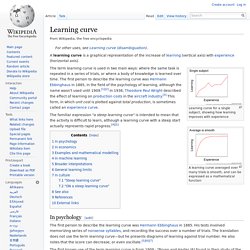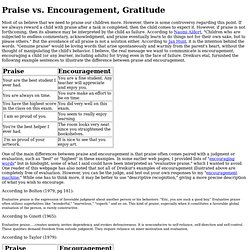

Study Tools. The Science of “Chunking,” Working Memory, and How Pattern Recognition Fuels Creativity. By Maria Popova “Generating interesting connections between disparate subjects is what makes art so fascinating to create and to view… We are forced to contemplate a new, higher pattern that binds lower ones together.”

It seems to be the season for fascinating meditations on consciousness, exploring such questions as what happens while we sleep, how complex cognition evolved, and why the world exists. Joining them and prior explorations of what it means to be human is The Ravenous Brain: How the New Science of Consciousness Explains Our Insatiable Search for Meaning (public library) by Cambridge neuroscientist Daniel Bor in which, among other things, he sheds light on how our species’ penchant for pattern-recognition is essential to consciousness and our entire experience of life.
Communication Skills - Johari’s Window. Learning curve. A learning curve is a graphical representation of the increase of learning (vertical axis) with experience (horizontal axis).

Learning curve for a single subject, showing how learning improves with experience A learning curve averaged over many trials is smooth, and can be expressed as a mathematical function. Bespoke Education. Bespoke Learning. Neuro Learning. New Memory Aids. New Learning. NewEd. EDUCATION. Other Learning. Top 40 Useful Sites To Learn New Skills. Formula for success in learning. If you have found this place in the vast cyberspace of the web, you are probably not the one to convince that knowledge is power, and that solutions to most problems facing humanity could be found if we were armed with more understanding of how the world works.

While knowledge is power, information can be overpowering. An increasing proportion of the population suffers from Information Fatigue Syndrome, i.e. from stress related to being overwhelmed with an unmanageable glut of information. This text introduces you to simple steps toward managing information and toward rock-solid knowledge. No cheap miracles. Just a clear and straight approach based on facts and science.
How 30 Minutes a Day Can Increase Your Intelligence. If you ask me, where humans go wrong is with their lack of patience.

That, and their recent acquired taste for instant gratification. The reality is that things take time. Richard Branson didn’t become a millionaire overnight. Madonna was not an overnight success. David Beckham was not born a superstar footballer. That said, it’s actually pretty easy to improve yourself. Because most people don’t bother. The majority of people don’t do a single thing to improve themselves.
So I’ve come up with a new theory: The Half Hour Theory. I love it because it’s actually pretty easy to integrate into your life. How to Ace Your Finals Without Studying. I’ve never been that keen on studying before an exam.

I rarely study for more than a half hour, even for big final exams worth more than half my grade. When I do study, I usually just skim over the material and do a few practice questions. For some of my math classes I have yet to do a single practice question for homework. Most people study by cramming in as much information before walking into the test room, whereas I consider studying to be no more than a light stretch before running. Mind - Research Upends Traditional Thinking on Study Habits. Buzzword: Micro-learning. I was introduced recently to a new buzz word making its way across the learning & development industry: Micro-learning.

If you’re like me, you’re probably starting to get a bit tired of people adding their particular spin to learning – all in search of the holy grail that is the “right way” to make learning happen. It doesn’t exist. But having got that out of the way, it is worth looking at these ideas to see if there’s anything we, as learning professionals, can learn from them. As a term, “micro-learning” has been around since about 2004, when it was put forward in a PhD thesis by Gerhard Gassler.
Basically, micro-learning describes a method of learning, whereby concepts and ideas are presented (or retrieved) in very small chunks, over very short time-scales, often at the point of need, or at the point of maximum receptiveness. Examples include: As can be seen from the examples above, micro-learning is generally pulled rather than pushed. ie. the learner dictates when they learn. Challenge Based Learning - Browse Challenges.
Praise versus Encouragement. Most of us believe that we need to praise our children more.

However, there is some controversy regarding this point. If we always reward a child with praise after a task is completed, then the child comes to expect it. However, if praise is not forthcoming, then its absence may be interpreted by the child as failure. Top 10 skills children learn from the arts. Nassim N. Taleb Home & Professional Page. Taxonomy of the Logical Fallacies. Thou shalt not commit logical fallacies. Crap detection, Evaluate. Critical thinking web. The Critical Thinker Academy.
Learning resources. Advice and resources on the subject of critical thinking.

Creativity: Divergent, Convergent, Abrasive, Etc. Divergent thinking – more than a mere tool – is a technique very commonly used on creative activities because it allows us to expand our brains a little bit, by looking for new opportunities and ways of getting things done.

So, from the problem – or whatever triggers your creativity – to the solution, instead of taking obvious steps and walking on a straight line, you force yourself to see different aspects of the situation, using unusual points of view, no matter how abstract of absurd they seem at the first place. This can be done by allowing everyone to think more freely while working on the task, gathering ideas that have the slightest relation to the problem itself rather than looking straight for a practical solution. Though it might sound like a waste of time, many corporations have found appealing answers to their problems by using such method. Another misconception around the divergent thinking is that the creative process should be all about it.